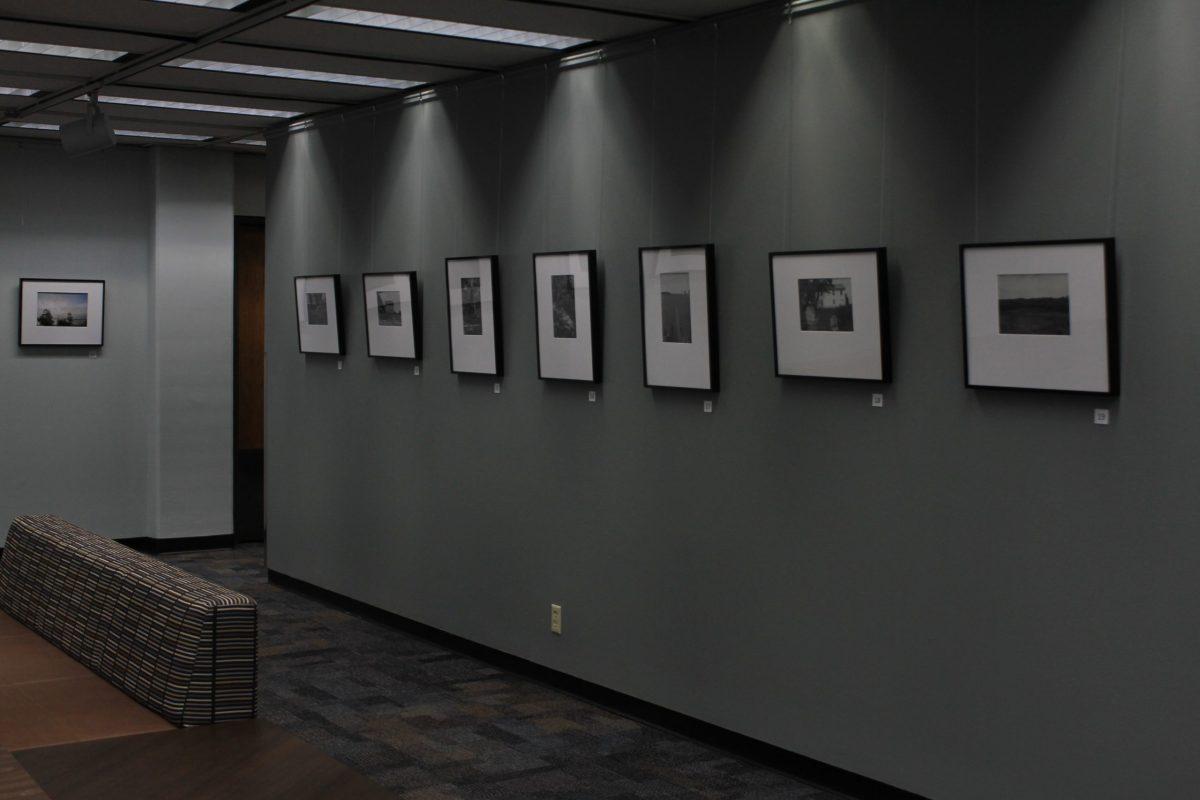Tucked into the second floor of the McDermott Library, amidst the bustle of a library during finals season, is a contemplative place. The Nebula Gallery’s current exhibit, “Echoes of History,” is a collection of photographs meditating on places at the heart of American history.
As a piece of the Comer Collection, a UTD teaching collection, the gallery has a focus on Civil Rights, the American West and the American landscape. Jessica Ingle, a research assistant and Ph.D. student in Humanities-Aesthetic Studies, curated the collection to explore how landscapes and physical places impact people’s collective memory.
“I titled it ‘Echoes of History’ because they really delve into the idea of the land and how it absorbs what we do on it,” Ingle said. “It also speaks to our memories as a nation. Space and place are really important to our memories as a society.” Ingle said. “These artists are all exploring how the land can be affected by us, but also affect us and affect our cultural consciousness.”
The exhibit’s focus on geography, identity, and aesthetics is not new to Ingle. Her dissertation, she said, is wrestling with similar themes.
“Recently, I’ve been exploring Texas contemporary art. I’m working with female contemporary Texas artists, but also the history of Texas and Texas identity and how that affects art,” Ingle said. “The southern identity, the impact of Texas, where we live — this affects things. I am still dealing with space and place in a way. There’s something unexplainable about the feeling we get in a space that we don’t necessarily account for.”
Ingle weaves together three photographers in this exhibition: Jeanine Michna-Bales, Noel Clark, and Kim Stringfellow. All three negotiate landscape and history.
Michna-Bales’s collection, “Through Darkness to Light: Photographs Along the Underground Railroad,” traces the physical locations of runaway slaves. The photographs follow a geographic and temporal arc — each photo’s location moves further north and becomes better lit over time. Ingle arranged the photos into groups of three.
“They’re darker. You really have to get up close to see a lot of the detail and to engage with them better,” Ingle said. “So, I broke them up in that regard.”
Most of the pieces are taken at night, when the poor lighting gives them a deep, rich flavor. They demand closeness. The final piece, however, has the sun high above the horizon. It is well lit and obviously set apart from the other pieces.
“The last image is actually titled ‘Freedom’ and it’s on Canadian soil. It’s symbolic of that moment of ‘We’ve made it’ and ‘Here’s the light and the power of the moment,” Ingle said.
Michna-Bales’s collection juxtaposes with Clark’s “Civil War, VA.” Trained as a photojournalist for publications like Time and Vogue, Ingle said she was initially hesitant to include the work.
“When I first started looking at these, I initially thought, ‘Oh, this is just a photojournalist perspective. It’s not that interesting. It’s not that artistic,’” Ingle said. “But when I really started to look at the way he shot these photographs, it’s very different from a photojournalist perspective.”
His pieces frame black and white photos of battle sites from the Civil War, but Ingle said they are not shot traditionally. For example, he photographs the sites of less important battles and viewers are placed in the center of the action.
“Matthew’s House” includes the house’s fence posts in the shot. The framing seems almost haphazard, like someone quickly turning around for a final glance.
“If you were just shooting a house, you wouldn’t include that, right? You would just shoot it in the traditional way,” Ingle said. “But instead he’s put it as if you are peeking through the fence posts to see that house. And to me, that really makes it more powerful.”
“Jackrabbit Homestead” by Stringfellow consists of photos of shacks in the middle of the American West as fossils of the Homestead Act, which encouraged eastern settlers to occupy the west and develop on the land. The homesteads bloom in beautiful, vibrant colors that juxtapose with the washed-out, natural horizon of landscape.
“I think that the nice thing, especially about Kim Stringfellow’s work, is that objectively, these are just beautiful photographs,” Ingle said. “You don’t need to have the background of knowing about the Homestead Acts to appreciate how beautiful they are.”
With the historical background, however, they are even more potent. One of the works in the collection is a framed land grant. Unlike the light, colorful photos of homesteads, it is black and white. It’s text-heavy and severe. Here photography carries this severity, but in a lighter visual context.
“The way she’s shown these shacks plunked down in the middle of the arid desert landscape points out this idea of wanting to own and dominate the land. That is so core to our American values,” Ingle said. “It’s part of the American dream to own a bit of land and that is really important to who we are as a country.”
“Echoes of History” is on display until Dec. 20, 2019 in the Nebula Gallery.
“It’s a great little space and they’re doing exciting things,” Ingle said. “People should keep an eye on what’s up here. It’s easy to be in the fog of studies and finals. But it’s also very easy to pop in here.”







